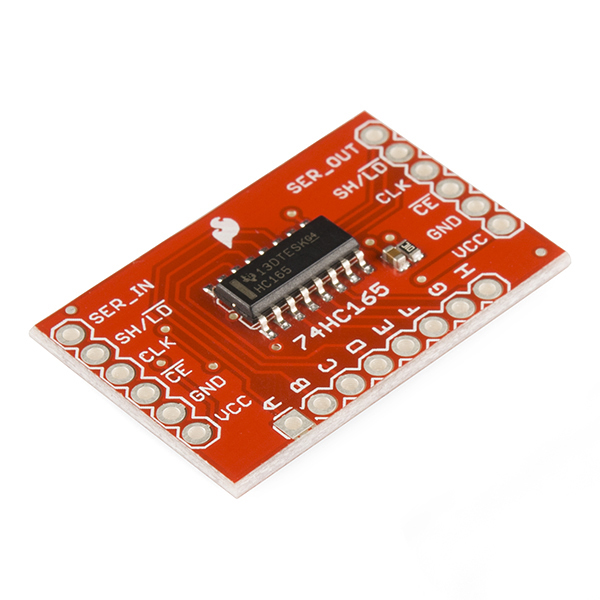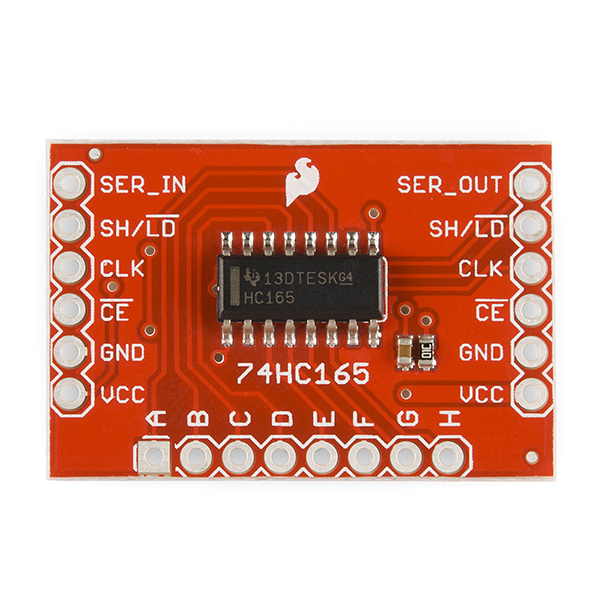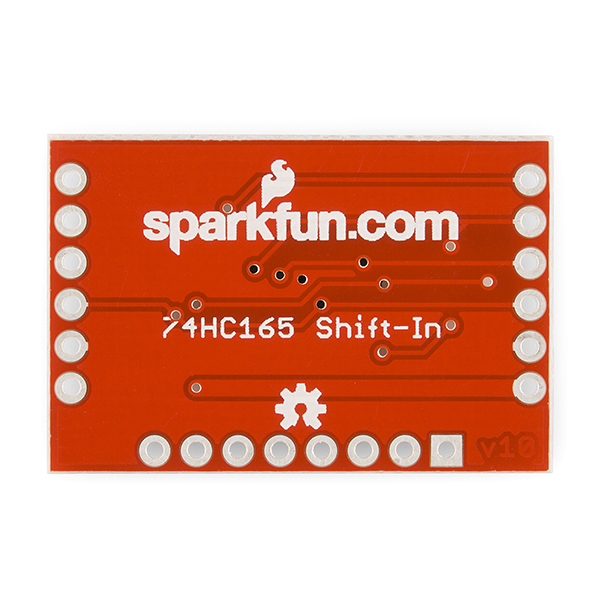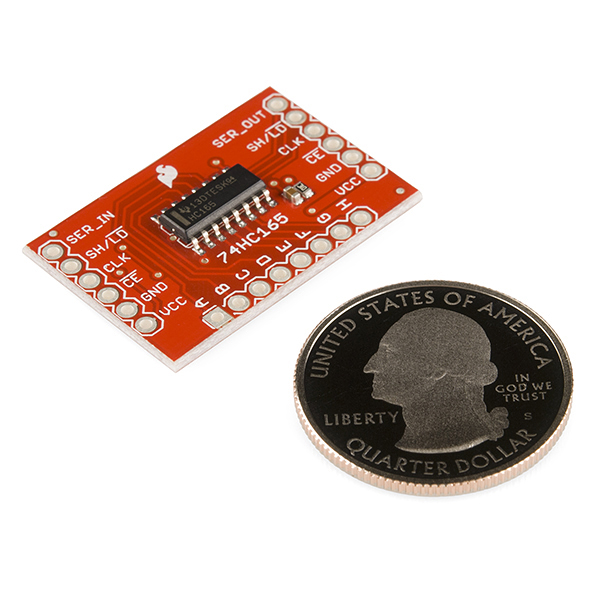SN74HC165 Shift-In Breakout
The SN74HC165N is a neat little IC that will take an input of up to 8 parallel lines and produce a single, serial output. It's a great way to increase the number of inputs on a microcontroller.
This breakout makes it easy to prototype using the 74HC165 by breaking out all of the pins you need to standard 0.1" spaced headers. We've also lined up the data and power pins so that you can easily make chains of them and expand the number of inputs under your control!
This chip works with a voltage supply anywhere in the range of 2-6VDC, and at clock frequencies of up to 29MHz (@6VDC).
Note: The SER_IN and SER_OUT labels are swapped.
- Wide Operating Voltage Range of 2 V to 6 V
- Parallel-to-Serial Data Conversion
- Outputs Can Drive Up To 10 LSTTL Loads
- Low Power Consumption, 80-μA Max ICC
- ±4mA Output Drive at 5 V
- Low Input Current of 1 μA Max
- Complementary Outputs
- Direct Overriding Load (Data) Inputs
- Gated Clock Inputs
- 0.1" Spaced Headers
- [Schematic](http://cdn.sparkfun.com/datasheets/BreakoutBoards/SN74HC165 Shift-In Breakout-v11.pdf)
- [Eagle Files](http://cdn.sparkfun.com/datasheets/BreakoutBoards/SN74HC165 Shift-In Breakout-v11.zip)
- Datasheet (SN74HC165N)
- Arduino Example
SN74HC165 Shift-In Breakout Product Help and Resources
Core Skill: Soldering
This skill defines how difficult the soldering is on a particular product. It might be a couple simple solder joints, or require special reflow tools.
Skill Level: Noob - Some basic soldering is required, but it is limited to a just a few pins, basic through-hole soldering, and couple (if any) polarized components. A basic soldering iron is all you should need.
See all skill levels
Core Skill: Programming
If a board needs code or communicates somehow, you're going to need to know how to program or interface with it. The programming skill is all about communication and code.
Skill Level: Rookie - You will need a better fundamental understand of what code is, and how it works. You will be using beginner-level software and development tools like Arduino. You will be dealing directly with code, but numerous examples and libraries are available. Sensors or shields will communicate with serial or TTL.
See all skill levels
Core Skill: Electrical Prototyping
If it requires power, you need to know how much, what all the pins do, and how to hook it up. You may need to reference datasheets, schematics, and know the ins and outs of electronics.
Skill Level: Rookie - You may be required to know a bit more about the component, such as orientation, or how to hook it up, in addition to power requirements. You will need to understand polarized components.
See all skill levels
Comments
Looking for answers to technical questions?
We welcome your comments and suggestions below. However, if you are looking for solutions to technical questions please see our Technical Assistance page.
Customer Reviews
No reviews yet.





hello, i need please a picture for the setup of components and i need please some codes that are simple to understand not like the hell codes of arduino website which are useless, spent hours trying to figure out how to make it works and nothing !!
Can these be used for interrupts? For example I'm working on a PC control ssytem that will read/adjsut coolant temp, fan speeds, pump speed etc. For 3 fans I'll need 3 interrupts. Can I hook one of these to an interrupt to read 3 fans with 1 interrupt?
Can someone more knowledgable tell me what would be the advantage of using this with an arduino uno to give it more inputs as opposed to just using an arduino mega that already has more inputs?
Here are a few examples:
Let's say you do have an Arduino Mega. But you want to read 1000 inputs. A bunch of these boards can handle it.
Let's say you have an ATtiny with only six pins, but you still want to handle more inputs. One or more of these board can handle it.
This general rule applies to any processor where you need more inputs than you have free pins.
One more: let's say you want to pipe a bunch (even thousands) of inputs back to any Arduino, but you don't want to run all those individual wires. With these boards, it only takes three wires to handle any amount of inputs you have. (With an additional select, the same three wires can be used to output data as well!)
tl;dr: shift registers can be a really powerful (and easy to use) tool in a number of situations.
If you've already got the Mega and don't need anything smaller, I'm not sure there is an advantage. But $4 + $30 is much less expensive than $60, and the Uno does have a smaller formfactor that works better for a lot of projects.
Don't you mean inputs in this line of the second para: "We've also lined up the data and power pins so that you can easily make chains of them and expand the number of outputs under your control!"
That is most certainly what I meant, thanks!
Please build an analog input version with 12bit resolution as well!
Shift registers are digital beasts, but we do carry a 16-input 1-output analog multiplexer that might be useful.